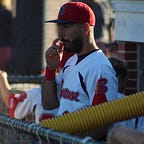Creating A System For Plate Discipline: Tech Use In The Practice Setting
Continuing to look at creating a system for Plate Discipline. If you want to read the other article it is linked below. Today we focus on setting up Rapsodo or other technologies to help give more feedback to players.
Practice is an area that has begun to change over the past few years for hitters. With teams moving toward a more challenging environment. This is a big step in the right direction in how players development. Today I don’t want to focus so much on the practice methodology but rather how we can incorporate technology into the practice setting to help us develop a system for plate discipline.
For the most part when coaches have used Rapsodo in the practice environment on the whole it has been used more as a batted ball feedback tool. What I am proposing does not mean that we don’t use it for that purpose at all. There is plenty of extra value that we can extract from this piece of technology that is not currently being taking advantage of.
How we set up our practice is not in the scope of this post so I am not going to touch on whether we use this machine for Live Batting Practice, or “Normal” Batting Practice, or even Front Toss. I want to focus on the idea that players should have access to the technology to confirm or deny what they are seeing during practice. Small changes will lead to better results over time.
Alright lets look at Rapsodo. To provide a visual of what the Rapsodo provides coaches, and player:
Great there is a bunch that we can focus on. Most importantly for this post I want to laser in on one specific area as we build this system. Specifically the Strike Zone in the bottom left. Just because we can focus on everything doesn’t mean that we have to. For this system I want to look at using an objective strike zone to give players feedback on pitch locations.
When working with hitters in the cage or on the field it is critical to allow players to seek their own feedback. This allow them to buy into the system that is being built while also allowing them to process information in their own way.
Honestly if you want to strip away some of the batted ball metrics it is even safe to use the Pitching Rapsodo which may be more helpful in this instance. I have included a picture of the pitching Rapsodo here as well. What is nice about this is that hitters get more feedback on the pitch type velocity that they may be facing. If you don’t want to provide information overload you might even consider taping or covering some of the information that might not be as helpful for your hitters. (This might not actually work unless you have someone throwing from the mound. Maybe if someone know feels free to send over a message. Never the less it is an idea.)
Here is a zoom in of the strike zone plot that we get for more reference:
Allowing the player access to this information in the training environment which will allow them to verify their own perceptions and continue to improve how they view the strike zone.
Similar to how the Mariners seem to be using the technology in this tweet from Andy McKay:
The one change I am proposing here is that instead of the Rapsodo Tripod being set up on the outside (or inside if you have a secure netting that might work) of the cage facing the coach/staff we flip the iPad to be on the open side of the hitter. This would allow the hitter to seek the feedback that he wants whenever he wants to check for a pitch location.
I would look for a setup that is similar to what the hitter has access to this tweet from Bill Hezel:
Or how Desi Druschel set up the Trackman to project the Strike Zone onto the big screen during Fall Games:
Currently we don’t have a lot of best practices besides a few glimpses into how a few people are using devices to help improve players plate discipline. (Note that I think in Desi’s case they were using it for Pitchers. But clearly there is an added effect for hitters)
Creating opportunities for players to collect and adjust real time information from this device is very powerful. If we just place the goal at getting better at strike zone recognition then I am still very skeptical that we will see real results without putting in a system and allowing space for players to seek feedback, and discover what they are seeing for themselves.
So far when thinking through what a system would look like we have:
- Clear And Consistent Reporting
- Practice Strike Zone Awareness
Adding more focus on Strike Zone Awareness during practice and allowing players to seek their own feedback should bring the player attention to how they think about the Strike Zone. When building a system like this out we need to understand that consistency is going to be key. Ultimately small changes will make bigger changes if we just continue to add small steps to how we develop better hitters.
Again nothing revolutionary here but when building a system based around topic putting ideas for a system together should help us in our planning of practice. Adding layers into how we consider ideas like this helps to build a more robust system for player development.
